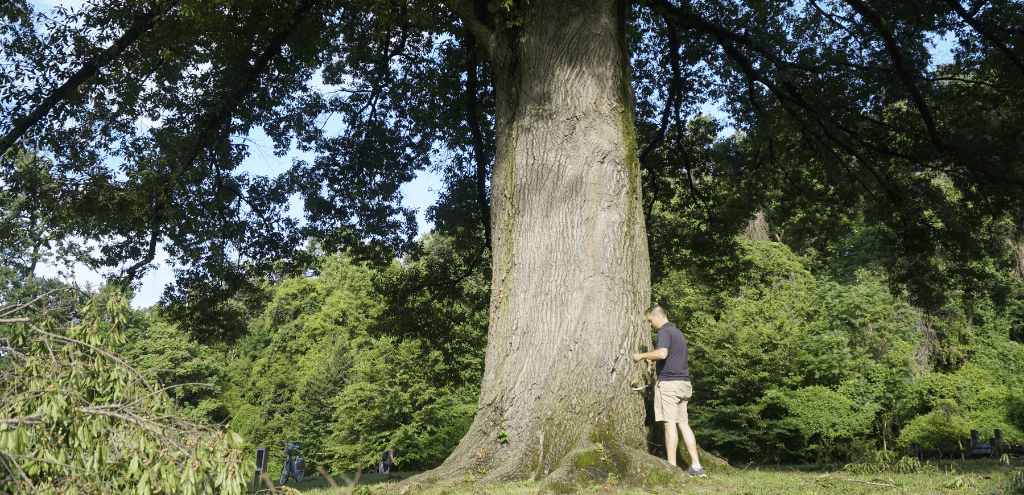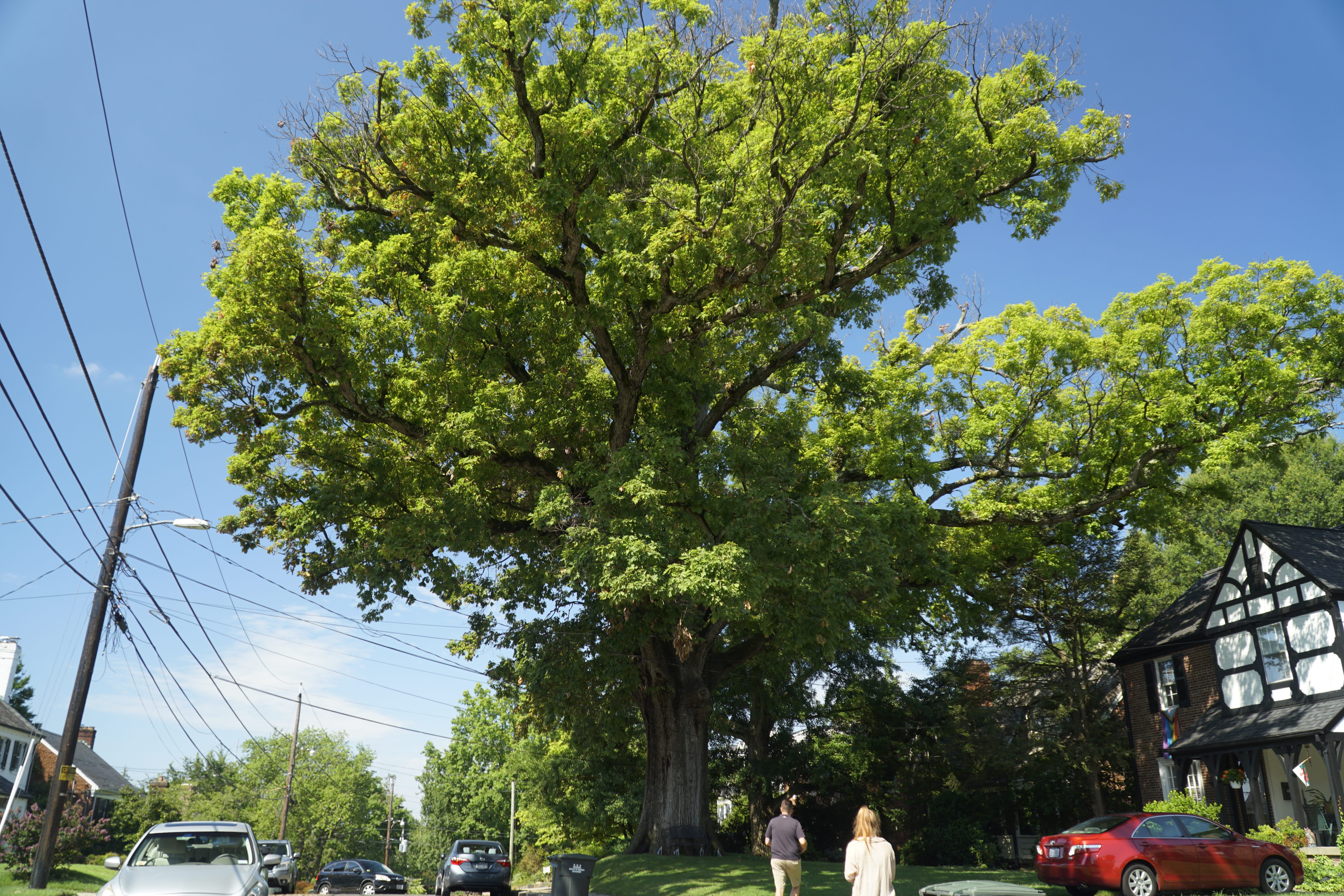
After a month of searching far and wide for the largest tree in DC, YOU, our citizen scientists out in the field have brought forward an answer! Throughout this search, we’ve been able to learn more about our local trees and gain a deeper appreciation of their history.

It’s important to remember that these trees didn’t get this size overnight. These are the trees that have survived, persevered, and even thrived against all odds. They’ve grown to massive heights despite climate change and the growth and development of our nation’s capital – and they’ve sat to watch the world around them change, time and time again. If trees could speak, we could only imagine the stories these trees would have.
Aside from the absolute majesty of the trees, we learned some really important factors about mature trees and keeping them healthy. First off, the early years of a tree’s life (much like humans) are a crucial time for development. A young tree’s structure and surroundings will determine how well they do for the rest of their lives. Obviously, other factors will play into their well-being over time, but overall, planting a tree correctly and caring for it in its early years will set it up for success in the long run.
Once trees are larger and more mature, maintaining their health can sometimes come down to just leaving the tree alone. Too often, people will try to climb older, large trees, and while we totally understand the temptation – it weakens tree limbs until they eventually drop or become hazardous. Another lesser-known factor that can contribute to the poor health of mature trees is compacted soil. This happens when the ground above the roots is overly walked on. This is important to remember when either choosing a location that will support the tree’s longevity or when admiring trees in our everyday lives.
Without further ado – on to our largest submissions and winners! Here are the top six submissions, verified by Casey Trees staff last week. Champion trees are verified through a point system that combines tree height, crown spread, and trunk diameter to determine how “big” a tree is. We used a hypsometer/rangefinder to estimate the heights of the winners, but generally, we’re basing the winners solely on circumference/DBH (diameter at breast height).
Northampton White Oak – 229″, 72.92″ DBH
This tree featured in a 2006 Washington Post article when Casey Trees led a similar campaign to find DC’s tallest trees, and was sent to us this time by a longtime friend and volunteer, Ulrich. It is located in the yard of his friend Ken, who unfortunately passed away recently. However, Ulrich was able to share that Ken loved this tree and took great care of it while he lived in the home, and it really showed! The tree is absolutely beautiful. Its shade covers the entire front yard and there was even a bench placed at the foot of the tree. We’re so grateful for Ken and the love he showed this tree, surely it will continue to thrive for years to come. Thank you to Ulrich for sending us the tree and some of the wonderful history behind it!
Tulip Poplar at Montrose Park – 235″, 74.84″ DBH
The next tree we verified was submitted by Luke. The tree in Montrose Park is hard to miss, and the area is fairly busy! While we were out measuring the tree for ourselves, there were even a few folks walking by who stopped to ask us what we were doing. Two women even pointed us in the direction of a nearby tree they thought might be even larger – however when they lead us to the second tree, its circumference was smaller by only a couple inches. Thanks to Luke for his submission!
Rock Creek Park Willow Oak – 250″, 79.61″ DBH
You may have seen this tree before – Emma sent in this massive willow oak, located right in the heart of the Rock Creek Trail Exercise Course, easily visible from the road. This was actually the first tree we set out to verify, and it really put into perspective just how large the submissions we received were. It made us personally rethink what it meant to call something a “large” tree. The spread of this tree easily covers all the nearby exercise equipment and benches, making it a spectacular resting spot for anyone walking through.
Northwest Willow Oak – 261″, 83.12” DBH
Next was a willow oak in a Northwest neighborhood sent to us by Liz. In case you haven’t noticed, this list is dominated by willow oaks! This could be due to the fact that young willow oaks grow very fast in the right conditions. While growth will eventually even out and slow down, this advantage gives them a great head start in becoming sturdy urban canopy goliaths! As you can see, the width of this tree is almost half the size of the home it sits in front of, and it was almost impossible to get the entire tree in the camera frame. Thank you to Liz for sending it our way and for getting your neighbor excited about trees!
Arboretum Willow Oak – 287″, 91.40″ DBH
 Next, we went over to the National Arboretum to find its famous willow oak – sent to us by John. Upon arriving, we were joined by Kevin Conrad, Supervisory Horticulturalist, Sue Greeley, Arborist and Wildlife Manager for the National Arboretum, and Cathy Kerkam, Director of Philanthropy and Communications for Friends of the National Arboretum. With their knowledge and expertise, they were able to not only take us to the tree but provide us with valuable information and insight into its health and history.
Next, we went over to the National Arboretum to find its famous willow oak – sent to us by John. Upon arriving, we were joined by Kevin Conrad, Supervisory Horticulturalist, Sue Greeley, Arborist and Wildlife Manager for the National Arboretum, and Cathy Kerkam, Director of Philanthropy and Communications for Friends of the National Arboretum. With their knowledge and expertise, they were able to not only take us to the tree but provide us with valuable information and insight into its health and history.
The tree is rumored to have been here since the Civil War, and while that may be a local legend – there’s a photo that can positively date the tree fully grown (though visibly smaller) in the 1940s. The tree obtained substantial damage during the 2012 derecho storm that ripped through the Midwest and Mid-Atlantic and was unfortunately never able to bounce back. From there, the tree was treated for Carpenter Oak Worms in 2015 and in the years since, continued to decay and obtain new damage from storms.
Sadly, this tree is near the end of its life. Though efforts from the arboretum staff have definitely extended the life and viability of the tree; Even now, the life cycle continues. With over 700,000 visitors to the Arboretum annually, guest safety is a top priority. Once the branches are trimmed back to prevent any of the rotting wood from becoming hazardous – the trunk of the tree will still provide a valuable habitat for the natural wildlife of the area. Serving a new purpose as the tree enters the next phase of the life cycle.
Learn more about the Friends of the National Arboretum and consider supporting them and their continued work to preserve and enhance the wonderful greenspace that is our National Arboretum.
Battery Kimble Chestnut Oak – 290″, 92.35″ DBH
Lastly, we went to measure the Champion Chestnut Oak located at the edge of Battery Kimble Park. While no one actually sent this tree in (Really y’all?!), the national registry listed the circumference as 276” back in 2012 – and we figured it was crucial to see if it grew. Luckily, we were right! Measuring the tree again in 2023 shows that it now has a circumference of 290” – making it not only the largest chestnut oak in the country but also the largest tree in DC! The multi-stem monster of a tree is located right off the road, with branches so tall, they tower over utility lines with no issue. Holding dual titles of largest species in the country and largest tree in the District only makes it more impressive!
Congratulations to John for sending in the largest tree to reach our inbox – the Arboretum Willow Oak! In case you forgot, John will be receiving a $100 gift certificate to our online store! Another huge congrats to our runner-up Liz for submitting the Northwest Willow Oak, you’ve won a $44 gift certificate to our store. Thank you again to everyone who followed along and participated in the search with us!
We will continue to keep our largest tree form active to accept submissions to be counted in future campaigns. There are surely other large trees out there hidden in our city.








